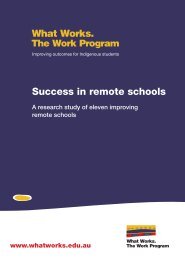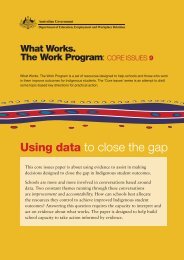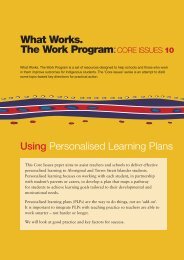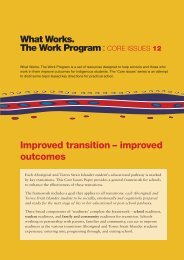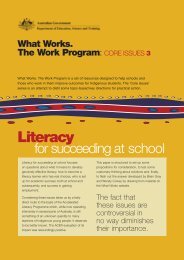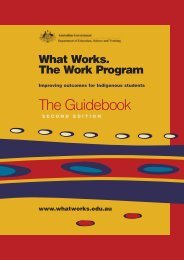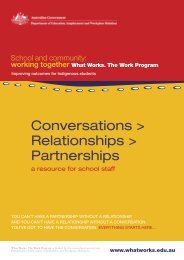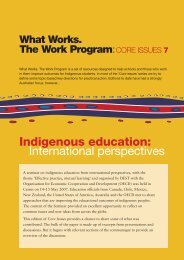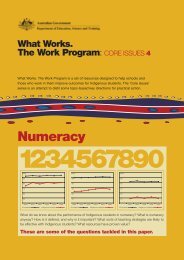Bound for Success Scope and Sequence Statements
Bound for Success Scope and Sequence Statements
Bound for Success Scope and Sequence Statements
- No tags were found...
Create successful ePaper yourself
Turn your PDF publications into a flip-book with our unique Google optimized e-Paper software.
SCIENCEEarth <strong>and</strong> BeyondConcept In Year 1the student:In Year 2the student:In Year 3the student:In Year 4the student:In Year 5the student:In Year 6the student:In Year 7the student:In Year 8the student:In Year 9the student:environment (e.g. wearingsunglasses <strong>and</strong> sunscreen;some sports not played inthe middle of summer)• Recognises that theenvironment can bechanged by people (e.g.l<strong>and</strong>-clearing, building).describes how they arehelping to do this at home<strong>and</strong> at school. SSevaporation <strong>and</strong>precipitation – rainfall)<strong>and</strong> makes connectionsbetween processes ofchange <strong>and</strong> changes to theenvironment including thelowering of the water tabledue to salinity <strong>and</strong> thedrying up of a lake orwetl<strong>and</strong>s.processes such as mining <strong>and</strong>l<strong>and</strong> clearing.interaction with theenvironment including theeffects of certain emissionson the atmosphere (theGreenhouse effect). Knowsthe effect of l<strong>and</strong> clearing onthe water table <strong>and</strong> how thisresults in l<strong>and</strong> salinityincluding its effects onfarming.• Knows that changes to theEarth occur over differenttime scales <strong>and</strong> usesgeological evidence tointerpret past events.• Knows that water isneeded <strong>for</strong> drinking,washing, cleaning <strong>and</strong> <strong>for</strong>the garden <strong>and</strong> that itshould not be wasted.• Knows the need to care <strong>for</strong>the environment. SS• Knows the importance ofconserving water <strong>and</strong> otherways of caring <strong>for</strong> theenvironment. SS• Identifies <strong>and</strong> describesmethods that humans useto prevent the effects oferosion including plantingson dunes <strong>and</strong> river banks<strong>and</strong> bringing in rocks toprotect the seashore.• Knows the relationshipbetween the seasons <strong>and</strong>water use <strong>and</strong> the need tobe constantly ‘water-wise.• Knows that pollution islargely caused by the useof some of the Earth’sresources (coal <strong>and</strong> oil)<strong>and</strong> the effect this ishaving on the naturalenvironment.• Knows that manypollutants come from carexhausts <strong>and</strong> knows thatthey can play a part inminimising this effect bywalking, taking the bus<strong>and</strong> riding their bike.• Knows the need to recyclerenewable <strong>and</strong> nonrenewableresources <strong>and</strong>products made from them.• Knows that differentgardens require differentamounts of water <strong>and</strong>recognises different waysto save water in gardens(including mulching, useof water-holding soils <strong>and</strong>drought-resistant plants).• Identifies man’s negativeimpact on the environment<strong>and</strong> underst<strong>and</strong>s humanresponsibility towardsenvironmentalmanagement.• Knows the finiteness offossil fuels <strong>and</strong> the need todevelop alternative energysources. Knows the need<strong>for</strong> the wise use ofresources <strong>and</strong> theimportance of recycling.Examines <strong>and</strong> describesways of reducing resourceuse in the community.Earth <strong>and</strong> Space• Knows that the sun canonly be seen during theday.• Associates the moon with‘night time’ <strong>and</strong> knowsthat sometimes they cansee the moon during theday [the moon is onlythere at night ∗ ]• Knows that the sun‘appears to’ rise in themorning, move in a setpattern across the sky <strong>and</strong>set in the evening.• Recognises that the moondoes not always appear tobe the same shape <strong>and</strong> thatsometimes the moon can’tbe seen at all (e.g. says“last week the moon wasjust a little piece of a circle<strong>and</strong> this week it is a halfcircle”).• Knows that the seasonsvary in different ways (e.g.length of daylight) <strong>and</strong> thatseason are related to thechanging position of theearth in relation to the sun.• Identifies a basic pattern tothe sun’s movement (e.g.says “the sun is overheadin the middle of the day<strong>and</strong> it comes up in themorning <strong>and</strong> goes down atnight”) <strong>and</strong> that features ofthe day <strong>and</strong> night skychange.• Explains using a model,that our sun is the centre ofour solar system <strong>and</strong> thatthe Earth moves around itevery year.• Knows that the moon doesnot support life <strong>and</strong> it isvery different from theEarth <strong>and</strong> that we knowthese things as a result oftelescopes <strong>and</strong> spacetravel.• Underst<strong>and</strong>s that the moon<strong>and</strong> stars are still in the skyduring the day but aremore difficult to see whenthe sky isn’t dark <strong>and</strong> thatsometimes we can see themoon during the daybecause its’ close to theEarth.• Knows that the moon doesnot ‘shine’ like the sun butmerely reflects the sun’slight ∗ .• Recognises the importanceof the sun <strong>for</strong> life on Earth.• Knows the features of themoon <strong>and</strong> compares it tothe Earth in explainingwhy nothing can live there.• Underst<strong>and</strong>s that theEarth’s revolving aroundthe sun once every yearresults in the differentseasons.• Uses models to underst<strong>and</strong>that the Earth rotates (onits axis) as it revolvesaround the sun <strong>and</strong> thatthis results in night <strong>and</strong>day.• Knows that planets do notshine but reflect the sun’slight <strong>and</strong> uses a telescopeto observe some of thesefeatures.• Knows that all planetsrevolve around the sun <strong>and</strong>the times they take to dothis vary.• Knows that the Earth’sorbit of the sun is close tospherical.• Examines the relationshipbetween the Earth, moon<strong>and</strong> sun, using models tounderst<strong>and</strong> the orbits withrelations to each other <strong>and</strong>exploring the effectsobservable from the Earth,(ie knows that as the Earthrevolves around the sun,the moon revolves aroundthe Earth, the Earth’srotation causes night <strong>and</strong>day, the Earth’s tilt causesthe seasons [ ∗ the Earth’sorbit of the sun is ellipticalresulting in summer whenit is closer to the sun] <strong>and</strong>can explain why it is hotterin summer usingappropriate reasoning).• Underst<strong>and</strong>s how themovement of the sun <strong>and</strong>moon affect the earth - thetilt of the earth causesseasons <strong>and</strong> the mooncauses tidal changes; thesolar <strong>and</strong> lunar eclipse <strong>and</strong>lights of the Aurora.• Knows the history ofman’s journeys to themoon <strong>and</strong> the resultingdiscoveries.∗ identifies common misconceptions in Science<strong>Bound</strong> <strong>for</strong> <strong>Success</strong> <strong>Scope</strong> <strong>and</strong> <strong>Sequence</strong> <strong>Statements</strong> V2 Page 51 Working Document Semester One 2007



